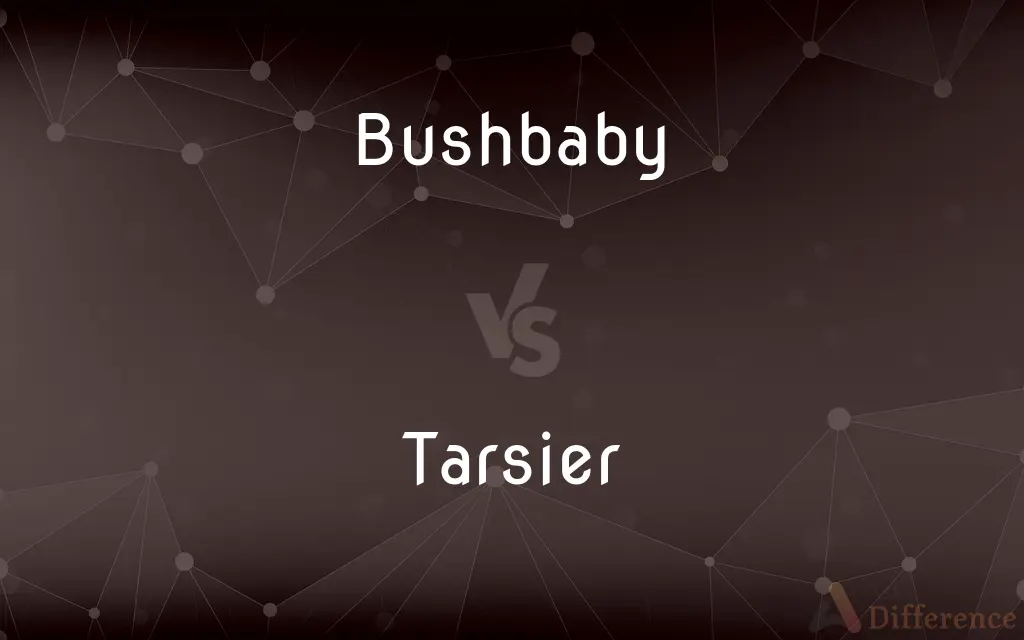Bushbaby vs. Tarsier — What's the Difference?
By Tayyaba Rehman & Maham Liaqat — Updated on March 25, 2024
Bushbabies are small, nocturnal primates with large eyes and powerful hind legs, found in Africa. Tarsiers, also nocturnal with large eyes, inhabit Southeast Asia, differing in their elongated tarsal bones and clinging vertical posture.

Difference Between Bushbaby and Tarsier
Table of Contents
ADVERTISEMENT
Key Differences
Bushbabies, belonging to the family Galagidae, are characterized by their ability to make long jumps, facilitated by their strong hind legs, while tarsiers, part of the family Tarsiidae, are distinguished by their elongated tarsal bones, enabling a unique vertical clinging and leaping ability. This anatomical difference underpins their distinct modes of locomotion within their nocturnal habitats.
In terms of habitat, bushbabies are primarily found across various regions of Africa, thriving in both woodland and savannah environments. On the other hand, tarsiers are native to Southeast Asia, particularly in forested areas of countries like the Philippines, Indonesia, and Malaysia. This geographical distinction points to the diverse evolutionary paths and ecological niches these small primates have adapted to.
When it comes to diet, both primates are insectivorous, with bushbabies also partaking in fruit and tree gums, showcasing their adaptability in foraging. Tarsiers, however, are more strictly insectivorous, with some species also hunting small vertebrates. This dietary preference underscores the specialized feeding strategies evolved by each to survive in their respective environments.
Social behavior varies significantly between the two, with bushbabies exhibiting both solitary and social traits, depending on the species. In contrast, tarsiers are mostly solitary hunters, coming together only for mating purposes. These behavioral patterns reflect the adaptation of each species to its specific environmental pressures and food availability.
Reproduction and lifecycle strategies also differ, with bushbabies typically having a gestation period around 110 to 120 days, leading to the birth of one or two offspring. Tarsiers, on the other hand, have a longer gestation period of approximately six months, usually resulting in a single offspring. These reproductive differences highlight the varied life history strategies that each species employs to ensure survival and continuation of their lineage.
ADVERTISEMENT
Comparison Chart
Habitat
Africa
Southeast Asia
Family
Galagidae
Tarsiidae
Locomotion
Leaping among trees
Vertical clinging and leaping
Diet
Fruits, insects, tree gums
Primarily insects, occasionally small animals
Social Behavior
Solitary or small groups, vocal communication
Solitary, less vocal, territorial
Reproduction
Seasonal breeding, shorter gestation, multiple young
Longer gestation, single precocial offspring
Unique Traits
Powerful hind legs, large ears
Elongated tarsus bones, head rotation capability
Compare with Definitions
Bushbaby
Possess keen night vision and acute hearing, aiding in nocturnal activities.
At night, the bushbaby's large eyes glow in the moonlight as it hunts.
Tarsier
Inhabit the tropical forests of Southeast Asia, adapted to a life of stealth and precision.
Hidden in the foliage, the tarsier remains virtually invisible to both prey and predators.
Bushbaby
Communicate with complex sounds and scent markings.
The bushbaby emitted a series of calls to communicate with its group.
Tarsier
Produce a single, well-developed offspring capable of clinging to vertical surfaces shortly after birth.
The newborn tarsier clung tightly to its mother as she leaped through the forest.
Bushbaby
Capable of making long jumps, using their powerful legs.
The bushbaby used its strong hind legs to leap across a wide gap between trees.
Tarsier
Known for their ability to rotate their heads nearly 180 degrees.
The tarsier turned its head sideways to scan its surroundings without moving its body.
Bushbaby
Nocturnal primates with large eyes and ears, known for their agility and jumping.
The bushbaby leaped effortlessly from branch to branch in search of insects.
Tarsier
Small, nocturnal primates with elongated limbs and large eyes, specializing in vertical clinging and leaping.
The tarsier clung to a bamboo stalk, ready to leap onto an unsuspecting insect.
Bushbaby
Adapted to various African environments, from woodlands to savannahs.
In the dense forest canopy, the bushbaby finds ample food and shelter.
Tarsier
Consumes a diet almost exclusively of insects, showcasing remarkable hunting skills.
With lightning-fast reflexes, the tarsier caught a cricket mid-air.
Bushbaby
An small, nocturnal, African primate, similar to a lemur.
Tarsier
Tarsiers are haplorrhine primates of the family Tarsiidae, which is itself the lone extant family within the infraorder Tarsiiformes. Although the group was once more widespread, all of its species living today are found in Maritime Southeast Asia, specifically the Philippines, Malaysia, Indonesia, and Brunei.They are found primarily in forested habitats, especially forests that have liana, since the vine gives tarsiers vertical support when climbing trees.
Bushbaby
Agile long-tailed nocturnal African lemur with dense woolly fur and large eyes and ears
Tarsier
Any of several small insectivorous primates of the genus Tarsius of Brunei, Indonesia, Malaysia, and the Philippines, being nocturnal and arboreal and having extremely large round eyes, a long tail, and long digits with nails except for the second and third toes, which have claws.
Tarsier
An insectivorous primate of the family Tarsiidae, having very large eyes and long feet, native mainly to several islands of Southeast Asia.
Tarsier
See Tarsius.
Tarsier
Nocturnal arboreal primate of Indonesia and the Philippines having huge eyes and digits ending in pads to facilitate climbing; the only primate that spurns all plant material as food living entirely on insects and small vertebrates
Common Curiosities
Are bushbabies and tarsiers related?
Both are primates, but they belong to different families and have evolved unique adaptations to their environments.
What do bushbabies eat?
They mainly consume fruits, insects, and tree gums.
How do bushbabies communicate?
Through complex vocalizations and scent markings.
What is unique about tarsiers' hunting skills?
Tarsiers have exceptional predatory skills, including the ability to rotate their heads nearly 180 degrees to locate prey.
What kind of social structure do tarsiers have?
They are primarily solitary, with pronounced territorial behavior.
Are bushbabies endangered?
Some bushbaby species are threatened due to habitat loss and hunting.
Do tarsiers live in groups?
Tarsiers are mostly solitary, rarely forming groups.
How long can bushbabies leap?
They can leap several meters in a single bound.
What distinguishes a bushbaby from a tarsier?
Bushbabies are African primates known for their leaping ability, while tarsiers, from Southeast Asia, specialize in vertical clinging and leaping due to elongated tarsus bones.
How do bushbabies and tarsiers differ in their reproduction?
Bushbabies have a seasonal breeding cycle and shorter gestation, while tarsiers have a longer gestation period and give birth to a single, precocial offspring.
How do tarsiers care for their young?
Tarsier parents are highly protective, with the mother carrying the single offspring until it can navigate the forest independently.
Can tarsiers rotate their heads like owls?
Yes, tarsiers can rotate their heads nearly 180 degrees, similar to owls.
Where can bushbabies be found?
In various African habitats, from woodlands to savannahs.
What adaptations help tarsiers in hunting?
Their elongated limbs, acute hearing, and the ability to remain motionless aid in their predatory success.
Why are bushbabies called so?
Their name comes from their distinctive, baby-like cries.
Share Your Discovery

Previous Comparison
Hate vs. Detest
Next Comparison
Emoji vs. EmoteAuthor Spotlight
Written by
Tayyaba RehmanTayyaba Rehman is a distinguished writer, currently serving as a primary contributor to askdifference.com. As a researcher in semantics and etymology, Tayyaba's passion for the complexity of languages and their distinctions has found a perfect home on the platform. Tayyaba delves into the intricacies of language, distinguishing between commonly confused words and phrases, thereby providing clarity for readers worldwide.
Co-written by
Maham Liaqat













































